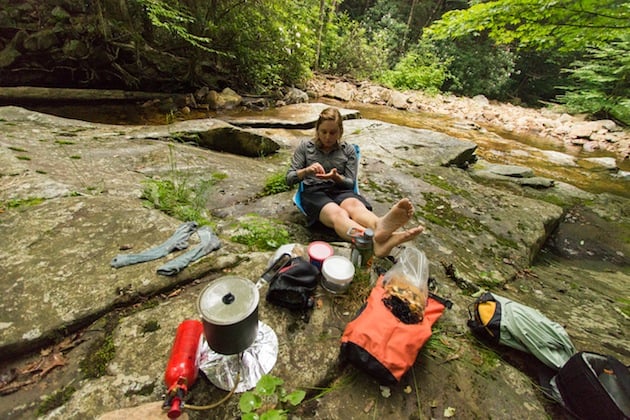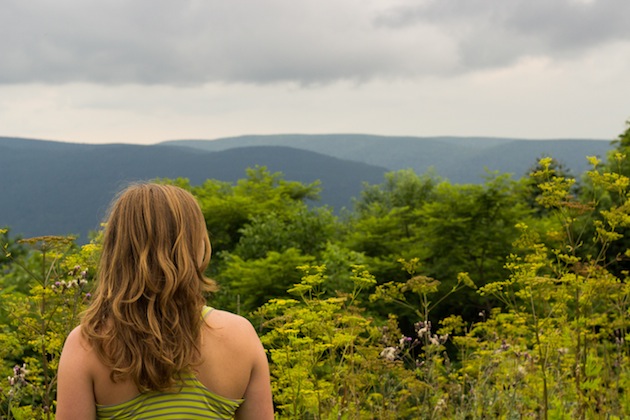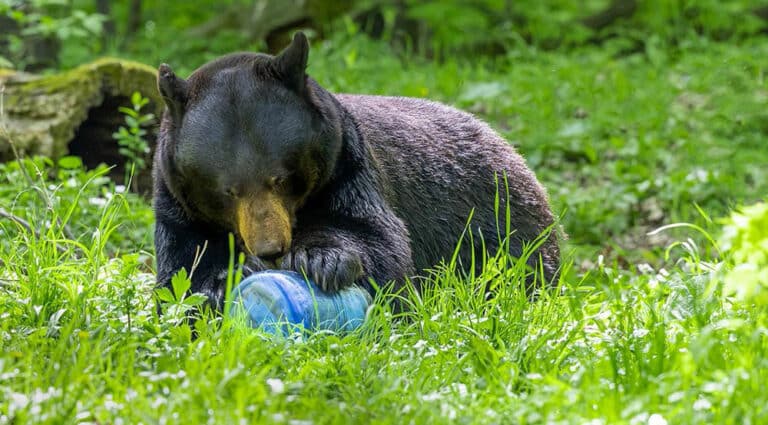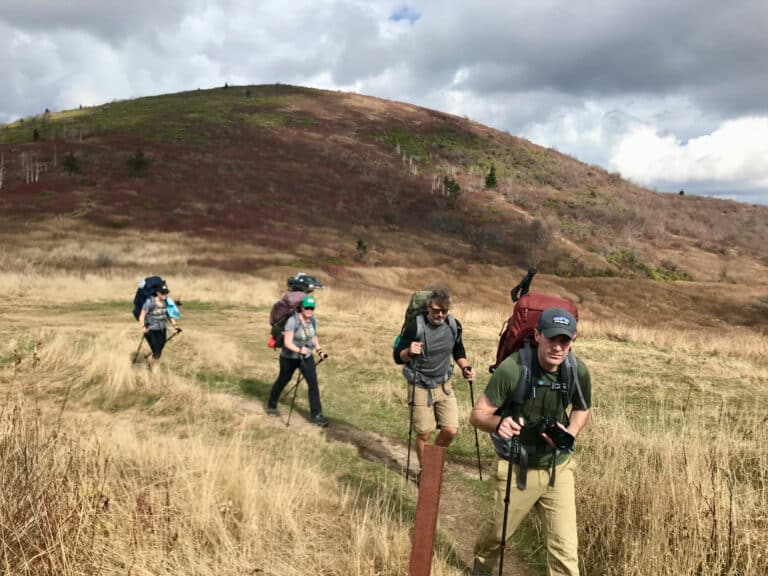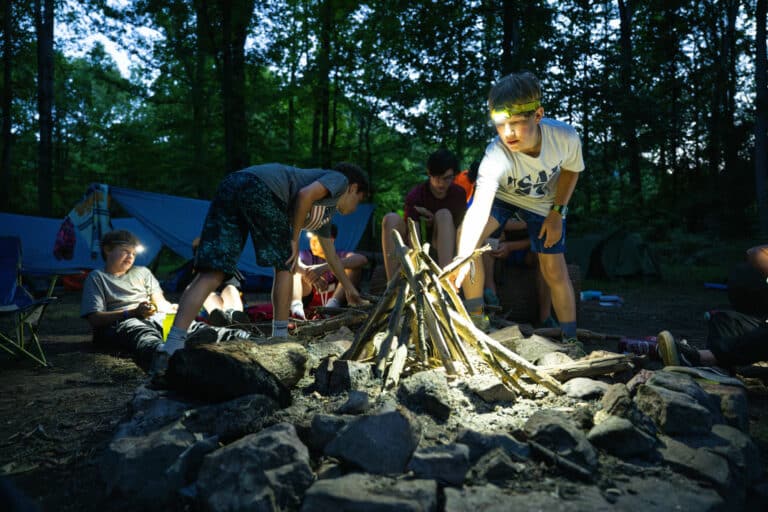The Wild Within
At 4 p.m. I stepped from the pavement of Route 150 to the saturated floor of the Cranberry Wilderness.
At 4:02p.m. I was lost.
At 4:05p.m. I saw a bear.
West Virginia’s Cranberry Wilderness is no joke. It’s a jeweled example of the wild, expanding for over 47,000 acres in the Monongahela National Forest. Established in 1983, the Cranberry Wilderness is home to a vast array of Arctic-like flora and fauna, the boundaries of which are defined by the Williams River to the north and the South Fork of the Cranberry River to the south. A former state black bear sanctuary and haven for animals such as bobcats and foxes, the Cranberry Wilderness is one of the wildest places east of the Mississippi.
Of course, I wasn’t thinking that as I stood in the drizzling rain with the trail map already in my face just two minutes into the hike. I confess: I’m no backpacker by any means. Hiking is okay. Sometimes. But to get the true wilderness experience in a designated wilderness area, hiking is about the only thing you can do.
As I drove up the Highland Scenic Highway to the trailhead, I felt like I was intruding on the wilderness. The road is bordered by thick groves of hardwood pines and red spruce that stand, shoulder to shoulder, in an impenetrable barrier. The precious strip of open sky above was a dreary shade of gray, the color of a storm with no intentions of leaving. Everything was eerily still. The silence, intimidating. Even the rain felt hushed. This was a far cry from most Friday evenings for me. Music playing. People talking. Cell phone buzzing. Cars honking. There’s always noise in my life.
So when I stepped from that strip of open sky into the coverage of the Cranberry Wilderness, it felt much like I had just jumped into a body of water and was sinking to the bottom, ears pulsating and muffled from the pressure. At first, my initial thought was one of sensory deprivation. Light, rain, and for a moment, even sound seemed to vanquish beneath the canopy.
After a moment, though, the magic of the wilderness opened up. The outlines of shoulder-high ferns and dense stands of spruce came into focus. Wildflowers and blooming rhododendron popped against lush shades of green. The forest smelled sweetly of pinesap. Birds of unknown origin chirped and twitted above.
This is what they write in fairy tales, I thought in awe.
I started walking, for I am not one to stand around too long and simply ponder. My brain was still churning from the morning’s emails, thoughts about deadlines, the growing to-do list. I trudged on, sloshing through the barely discernible trail, weaving through tree trunks and soaking up droplets from waterlogged undergrowth.
Immediately, something told me to stop. I looked up. I knew the trails weren’t marked in wilderness areas, but I didn’t imagine they would be that hard to keep track of. Yet the more I stared at what I had assumed to be the trail beneath my feet, the more uncertain I felt of that assumption. I backtracked, thinking I might see some signage to direct me the right way.
I saw nothing.
Frustrated, I reached around and opened the top of my pack, pulling the wilderness map from its Ziploc bag. As I unfolded it, the sound of a branch snapping nearby caught my attention. I whipped around.
The equally surprised face of a young black bear stared back at me some several yards away. We looked at each other in quiet assessment for just a moment before he turned, crashing into the forest. I watched him go until the last black patch of his rump had disappeared. Returning my attention to the map, I faintly recalled a description I had read in a guidebook at some point, something about the trail passing by an information kiosk.
I looked around, scanning the endless greenery for the elusive kiosk until finally, out of the corner of my eye, I saw a sliver of what appeared to be a roof. I parted a meadow of unkempt grass that stood navel-high and found, to my surprise, the information stand! I looked back at the trail I had created. Surely the rest of the hike would not be like its bushwhack of a beginning.
And it wasn’t, at least initially. I hiked and hiked for hours, passing mushrooms of every variety and meadows so lush and mystical, I thought for sure I had stepped through the wardrobe and into the land of Narnia. Every few yards I would find myself dodging (or, more often, getting hit square in the face with) an extensive spider web system. Their master spinners were sometimes as large as my clenched fist.
My watch beeped. I looked down, surprised to see that it was already 7p.m. As if on command, like I had summoned it to appear, one of the most amazing campsites I have ever seen beckoned to me from below the trail. I hopped down, breaking through tangled brush and sliding on my butt down a muddy embankment to McClintock Run, a mere trickle of a tributary.
By 8p.m. I was fed but exhausted. The rain had let up, or so I assumed, though the leaves continued to shed raindrops throughout the evening.
By 8:30 p.m. I was nestled in my cocoon of a hammock, fast asleep.
At 3a.m., I awoke to the loud split-crack-woomph of a tree falling nearby. It shook the ground beneath me, so much so that I thought its branches would surely rip through my rain fly and crush me. It was a cold night, much colder than I had anticipated, and I shivered in my 50-degree sleeping bag as I anxiously tried to rock myself back to sleep.
At 6a.m., I wearily came to again, feeling much like a tractor-trailer had t-boned my forehead. Pounding temples, achy body, sore throat, congested nose. I dismissed it, thinking my luck had finally run out and I was no longer immune to allergy season. I wanted to start hiking, though I’d promised myself I would take my time, relax at camp, and read. Specifically, I told myself, I would read Wallace Stegner’s legendary “wilderness letter.”
An American novelist with a passion for the environment, Stegner wrote a letter to the Outdoor Recreation Resources Review Commission in 1960 that helped inspire the American people to support one of the most important decisions this country has ever made for our wild spaces: passing the Wilderness Act of 1964. This year marks the 50th anniversary of that significant achievement, so I found it appropriate to read his letter during my first solo wilderness experience.
“Something will have gone out of us as a people if we ever let the remaining wilderness be destroyed,” he wrote. “Without any remaining wilderness we are committed wholly, without chance for even momentary reflection and rest, to a headlong drive into our technological termite-life.”
At 9:30a.m. I started to pack up camp. While I worked, I considered Stegner’s phrase, “technological termite-life,” and how at times, I thought of my own world as nothing more than a twisted mess of screens and cords and cables. I pondered his words, admiring the man for his wisdom and foresight, as desolate a descriptor as it may have been. My technology-riddled days were what led me to backpacking in the Cranberry Wilderness in search of quiet, some momentary respite from the chaos of life. I could feel all-too-acutely Stegner’s presence there underneath the seeping canopy, hopefully looking on in approval of my decision.
I hoisted my pack onto my knee, sliding my arm through the strap and shifting its weight around. It seemed heavier than the day before, perhaps from the soaked gear that now sat hard above my hips. Ignoring my aching body and already pruney feet, I picked my way through the vegetation up to the trail again.
By 10 a.m., the previous day’s cakewalk of a hike turned sourly difficult. Head reeling, heel rubbing, calves burning, patience waning. I got off trail a number of times, spending precious minutes retracing my steps to the last stone cairn, which was randomly placed where the trail simply disappeared. The gentle downhill gradient had turned into a stiff uphill march, and I knew it would only get worse for the remaining 10 miles of my planned loop. I knew, too, that those last 10 miles constituted the most rugged terrain in the wilderness and were, consequently, the sections where hikers were more prone to getting lost.
At 11:30a.m. I collapsed on the ground, berating myself for feeling so weak. My body aches had not subsided, and I feared my “allergies” were really the onset of a head cold. What’s more, a quick peek beneath my grimy socks revealed a hot spot on my left heel, which I was feeling too stubborn to tend to. I glanced at the map to check my progress: only a mile-and-a-half gained in about an hour-and-a-half of hiking. Swell.
By 11:34a.m. I threw in the towel. The rain had picked up significantly again, and if my assumptions about my health were correct, another cold and wet night in a hammock would surely not help any.
I’m never okay with giving up on anything, though. To an onlooker, I must have appeared much like a puppy that had just been punished for peeing on the carpet, tail between her legs, head down. I spent the first few hours of my return hike chastising myself for not bringing echinacea or whiskey or whatever it is people use to jumpstart their immune systems. For choosing to bring my lightweight summer bag instead of the warmer down alternative that sat high and dry back at the trailhead. For thinking, no matter how distantly, that I just might be able to make it through this wilderness experience unscathed.
By 3:57p.m. I was sitting in the car, shivering in my soaked clothes and blasting the heat. I hadn’t eaten since earlier that morning, but I had no appetite. I was feeling too deflated, too defeated. I put the car in drive and pulled out of the trailhead parking lot.
It wasn’t until a few weeks later that my time in the Cranberry Wilderness really started to mean something other than a failure. I was visiting my parents at their home and found myself flipping through a copy of my college honors thesis, in which I sought to answer why seemingly normal people with families, 9 to 5 jobs, and a load of other responsibilities still risked life and limb in pursuit of adventure. I concluded in agreement with a sociologist from Norway, Gunnar Breivik, who said, “We need to save the wilderness around us, but also the wilderness within us. We need to let l’homme sauvage, the wild human being, get a fair share of our life.”
Immediately my thoughts turned back to those 24 hours in the Cranberry Wilderness. In total I had hiked only 13 miles instead of the intended 23. It wasn’t groundbreaking or book-worthy. It certainly wasn’t the hardest thing I’d ever done, nor was it necessarily easy. But it also wasn’t a failure by any means, like I’d been letting myself believe for the past month.
In Stegner’s Wilderness Letter, he advocates for the preservation of wilderness areas, for “it was the challenge against which our character as a people was formed.” The bushwhacking, the unmarked trails, the unforgiving weather. The challenges I faced in the Cranberry Wilderness pale in comparison to the obstacles our ancestors encountered. Although those conditions largely defined my hike, it was through those bumps in the road that I was permitted a momentary break from the stresses of everyday life. I was allowed, or more appropriately forced, to tap into my l’homme sauvage, my wild being, if only for those 24 hours. In the face of hypothermic conditions, a weakening immune system, and the potential for getting helplessly lost, suddenly my worries about returning emails seemed petty at the most.
Stegner talked about how even the simple notion of a wilderness existing somewhere in the world was enough to sustain a human being. But now, 50 years later, I have to disagree. I think we need more than just the idea of wilderness in our lives. We need the real thing. We need to feel in our very bones what the temperature is at night. We need to wake not to any alarm but to the rising of the sun. We need to let nature reclaim a bit of our soul and reignite the wilderness that resides in us.
–Jess Daddio is Blue Ridge Outdoors’ travel editor. Follow her adventures at LiveOutsideAndPlay.com.

